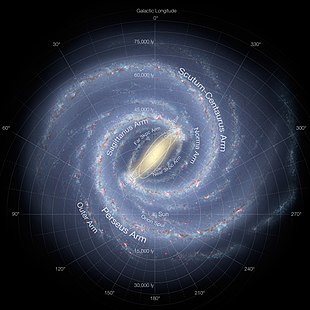
In 1944, Walter Baade categorized groups of stars within the Milky Way into stellar populations. In the abstract of the article by Baade, he recognizes that Jan Oort originally conceived this type of classification in 1926.[1]
Baade observed that bluer stars were strongly associated with the spiral arms, and yellow stars dominated near the central galactic bulge and within globular star clusters.[2] Two main divisions were defined as Population I star and population II, with another newer, hypothetical division called population III added in 1978.
Among the population types, significant differences were found with their individual observed stellar spectra. These were later shown to be very important and were possibly related to star formation, observed kinematics,[3] stellar age, and even galaxy evolution in both spiral and elliptical galaxies. These three simple population classes usefully divided stars by their chemical composition or metallicity.[4][5][3]
By definition, each population group shows the trend where lower metal content indicates higher age of stars. Hence, the first stars in the universe (very low metal content) were deemed population III, old stars (low metallicity) as population II, and recent stars (high metallicity) as population I.[6] The Sun is considered population I, a recent star with a relatively high 1.4% metallicity. Note that astrophysics nomenclature considers any element heavier than helium to be a "metal", including chemical non-metals such as oxygen.[7]
- ^ Cite error: The named reference
Baade-1944was invoked but never defined (see the help page). - ^ Cite error: The named reference
Shapley-1977was invoked but never defined (see the help page). - ^ a b Cite error: The named reference
Gibson-etal-2013was invoked but never defined (see the help page). - ^ Cite error: The named reference
Kunth-Östlin-2000was invoked but never defined (see the help page). - ^ Cite error: The named reference
schonrich2009was invoked but never defined (see the help page). - ^ Cite error: The named reference
Byant-2005was invoked but never defined (see the help page). - ^ Cite error: The named reference
metalwas invoked but never defined (see the help page).